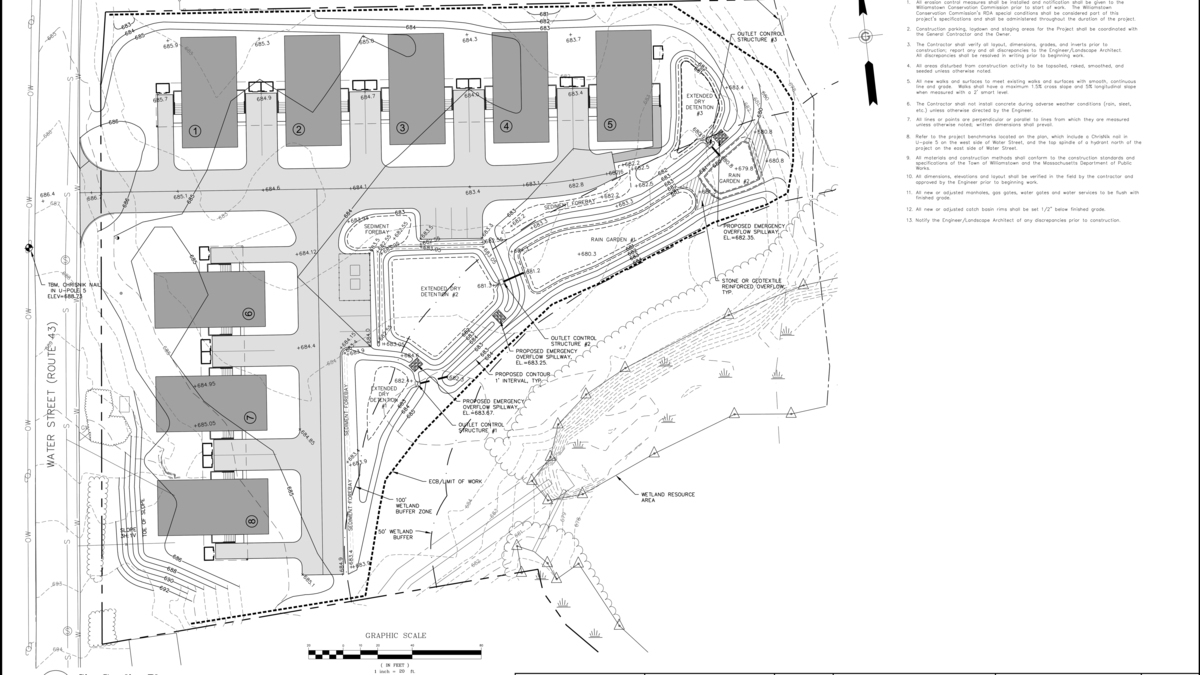Williamstown Con Comm OKs Water Street DevelopmentBy Stephen Dravis, iBerkshires Staff
07:20AM / Sunday, June 25, 2023 | |
 The current layout of a planned residential development on the site of the former Williamstown Grange Hall on Water Street. The current layout of a planned residential development on the site of the former Williamstown Grange Hall on Water Street. |
WILLIAMSTOWN, Mass. — The Conservation Commission on Thursday set conditions for what is now planned for a 16-unit residential development on the site of the former Grange Hall on Water Street.
Engineer Charlie LaBatt of Guntlow and Associates appeared before the Con Comm to explain the erosion and stormwater management plan for the project, which has been scaled back considerably from when it first was discussed at Town Hall about a year ago.
At one point, developers Hicks Stone and Bill Freeman talked about placing as many as 28 units on the 6.6-acre site, a concept that would have included four apartments in the existing Grange Hall.
"Further evaluation of the Grange Hall has shown it's not feasible to restore — financially not feasible, practically not feasible," LaBatt said. "The structure itself is complicated at best."
So now the developers, who are working with resident Alex Carlisle, the property's owner, intend to build eight modular duplex homes at the site — three roughly where the Grange Hall currently stands at 584 Water St. and five in a row from west to east at the north end of the property, starting near Water Street (State Route 43).
Hicks and Freeman plan to market a percentage of the 16 units in the eight buildings as income-restricted properties, where the cost of ownership will, in perpetuity, be affordable to residents making up to 80 percent of the area median income.
Thursday marked the second time that the Water Street proposal has been in front of the Con Comm. Previously, the commission had determined that the project would not need to file a Notice of Intent based on the distance of the planned homes from the nearby Green River, a resource area under the commissions' jurisdiction under the Wetlands Protection Act.
A neighbor appealed that decision to the Department of Environmental Protection, which decided an NOI should be filed, LaBatt said.
At Thursday's hearing, the commissioners reviewed the NOI.
LaBatt explained that the new configuration of the property with eight new buildings and associated driveways was a net reduction in impervious surface area from prior iterations.
"Ultimately, it ends up in a slight reduction in stormwater management, recharge volumes, stuff like that, but, for the most part, we left them unchanged," LaBatt said.
"We typically go into a design like this assuming the worst case. We modeled this as if there's no [on site] infiltration happening while it's raining, even though we no darn well it will be happening. We've modeled the detention area, the pond, to make sure it's big enough in the worst case scenario to make sure we don't have peak flows [toward the river] greater than pre-development in the 2-, the 10- and the 100-year storms."
LaBatt said he was conservative in his design of features like "dry detention" areas and rain gardens that will be employed to keep runoff and sediment from reaching the Green River.
"In reality, this site is very permeable," he said. "Most of the time, you shouldn't see any runoff, even heading toward the ponds, never mind, ultimately, out of the rain garden."
LaBatt said part of the reason for the appeal to DEP was to determine the status of an oxbow of the Green River that runs along the eastern side of the property. The vestige of the river, which now runs north and south farther east from the planned constriction, is considered an intermittent stream, unlike the perennial Green River, and thus subject to different regulations for nearby development.
The commission agreed with the DEP's assessment that the oxbow is an intermittent stream.
It also gave the project its regulatory blessing after adding five conditions to the standard 25 for any work in areas under the panel's jurisdiction: that work may not commence until a stormwater pollution prevention plan is filed; that the project's stormwater plan include a schedule for maintenance of detention areas post construction; that the meadows and open spaces on the site be mowed no more than once a year — after Nov. 15 and before April 15 of the succeeding year; that meadow areas and rain gardens be planted with a New England meadow mix; and that native trees be planted near the intermittent stream if appropriate.
LaBatt said the project also will be before the Zoning Board of Appeals, which will look at any tree planting plans.
In other business on Thursday, the Conservation Commission approved a plan to create a private trail system on a property at 121 Treadwell Hollow Road near Hemlock Brook south of the Taconic Trail State Park.
The owner of the home at that address sought and received permission to remove small brush to create trails to the river to take advantage of a swimming hole.
| 
